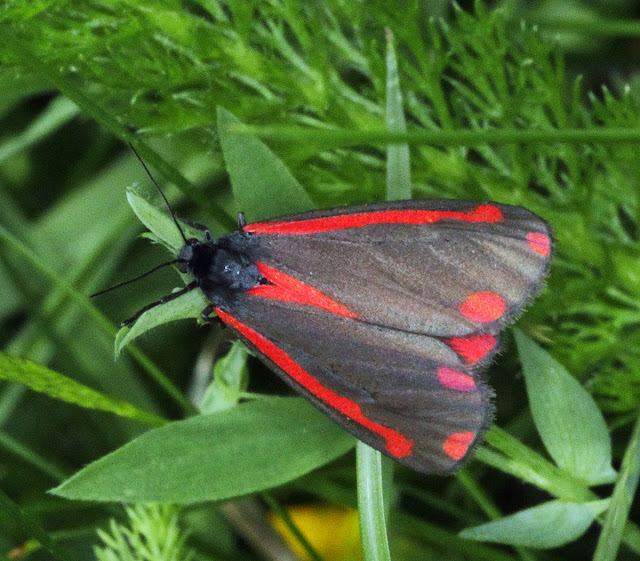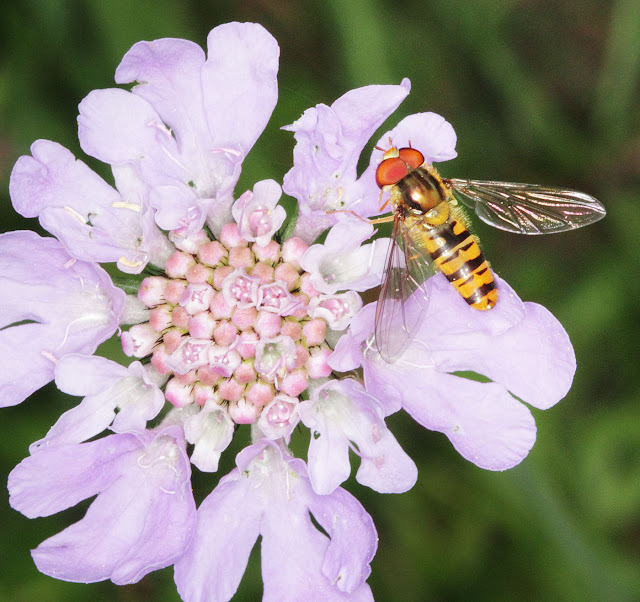 |
| Riddlesdown Quarry from within the security fence, 2 July 2011. |
Both the common and the quarry are spectacular. First, a long straight path through open grassland, thought to be on the route of a Roman road. Excavation is needed to confirm this. Grassland, and some trees and scrub off to the sides; the common is being actively managed to increase the open grassland. The wildflowers were profuse. I saw several which were new to me, or if I had seen them before I didn't know at the time what they were. Vervain, Dropwort, Tufted Vetch, Rest Harrow. Spear Thistle and Welted Thistle. The Mignonette looked very much like the garden plant of the same name that I remember from my childhood.
 |
| Long-headed poppy, Papaver dubium subspecies dubium, in Riddlesdown Quarry. 2 July 2011. |
The common is open to all, but the quarry is surrounded by a tall metal security fence, and there are two locked gates to get through before reaching the edge of the excavation. It is a spectacular sight. Geologists would love it. Until 1996 it belonged to Blue Circle, a company that sold cement, but they had not taken chalk for some while before that.
There were a few butterflies around on the grass plateau outside, but when we went in we were suddenly surrounded by them; Meadow Browns, Ringlets, Marbled Whites and some Skippers, fluttering around, disturbed by our passing. And there were more plants, different again. Some were vivid, with strong colours, like the Everlasting Pea and the Long-Headed Poppy; others had clear pastel shades like Centaury and Restharrow.
Kidney Vetch, the food of the caterpillar of the scarce Small Blue butterfly, was all around, but we did not see the butterfly, though it is known to live here. Hop Trefoil, Eyebright, Rosebay Willowherb, many plants with beautiful and evocative names. And I discovered from one of the walkers that Bird's-Foot Trefoil, sometimes called eggs-and-bacon here, is called "old women's teeth" in Sweden.
 |
| Hop trefoil, Trifolium campestre, in Riddlesdown Quarry. 2 July 2011. |
The path winds down into the centre of the quarry, where we looked around for a while, and then back up and home again. The walk was advertised as three hours. We started off at 10 a.m. and got back to the car park at 1:30 p.m. It did not seem a long time. There is only one chance each summer to visit the quarry, and I will definitely book early next year.
This was a good chance to try out my new camera, a Canon EOD 60D, and all the closeup photos were taken with that and my 100mm macro lens. The wide view of the quarry, and the view of the group, were taken with my little Canon Ixus 100. As usual, these photos show only a tiny fraction of the good things there were to be seen.
 |
| Matt Johnson addressing the group at the top of Riddlesdown quarry. 2 July 2011. |
 |
| Common centaury, Centaureum erythraea, in Riddlesdown Quarry. 2 July 2011. |
 |
| Cinnabar moth, Tyria jacobaeae, in Riddlesdown Quarry. 2 July 2011. |
 |
| Round-leaved wintergreen, Pyrola rotundifolia, in Riddlesdown Quarry. 2 July 2011. |
 |
| Wolf spider hunting under the grass, carrying her young on her back, in the meadow above Riddlesdown quarry. 2 July 2011. |
These spiders are quick-moving hunters and they don't hang around and pose for the camera. I have seen lots of wolf spiders this summer, but I have very few photos.
 |
| Marmalade hoverfly, Episyrphus balteatus, on a small scabious, Scabiosa columbaria, on Riddlesdown Common. 2 July 2011. |
Hello Bill, Just stumbled on your blog whilst looking for pictures of the hairy fly Tachina fera. This post is a lovely introduction to the quarry. Makes me want to visit! Would like to see that wintergreen. Good to find another botany/nature blog online :-) Lovely pictures. Mel
ReplyDeleteThanks! The quarry is amazing, really worth a visit. I will post a nice T. fera photo in a week or so. (I have some posts already queued up.)
ReplyDeleteBill
Hi Bill. Excellent. Look forward to that. Pretty sure I id'd it right. I live up in Bedfordshire, so bit far for me to go quarrying down your way. Mel
ReplyDelete